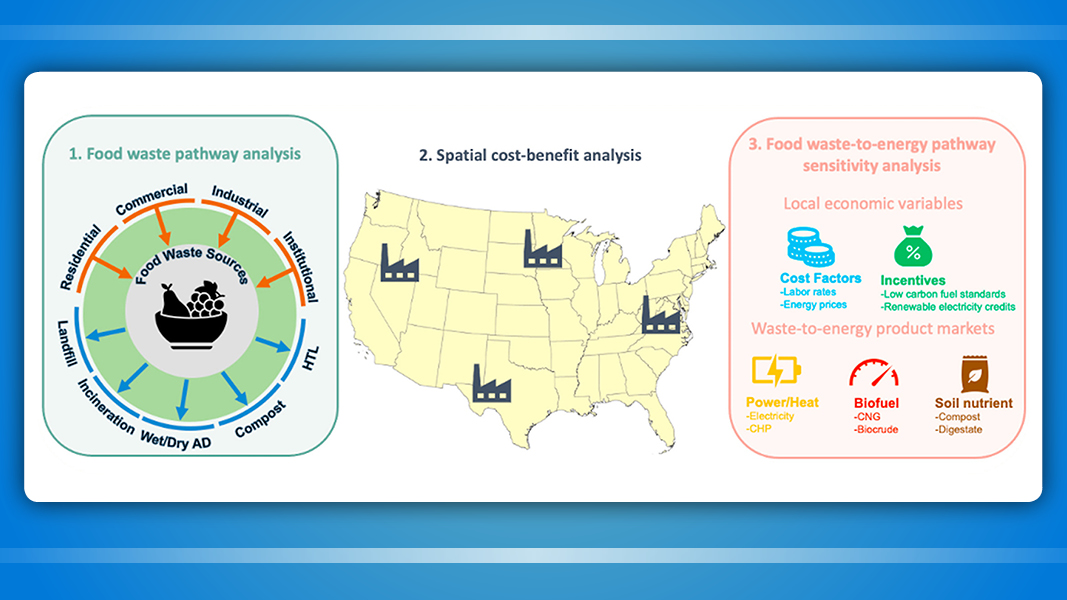Top: Image courtesy NREL
The expected decline in the number of landfills across the United States coupled with bans on disposing large amounts of organic waste in landfills that have been enacted in multiple states prompted researchers at the U.S. Department of Energy’s (DOE’s) National Renewable Energy Laboratory (NREL) to examine other ways to grapple with the issue of food waste disposal. The researchers, Alex Badgett and Anelia Milbrandt, determined no single solution exists in the U.S. after examining the economics involved in five different ways to handle disposing of food waste, including tossing it into a landfill. Both researchers are part of NREL’s Strategic Energy Analysis Center.
“If we are trying to develop an optimized waste management system in the U.S. that diverts all food waste from landfills, there is not necessarily any one technology that will work for all areas of the country,” notes Badgett. “An optimized system would likely use different technologies in different locations and at different sizes.” About 75% of food waste winds up in landfills, but many landfills are running close to capacity and a significant number are scheduled to close by 2050, the researchers found. Although sufficient land is available for new landfills in rural America, more populated regions will be forced to transport waste long distances for disposal. Secondly, organic waste disposal bans enacted in several states require disposal of food waste in facilities other than landfills. Given a need for investment in new waste management facilities, an opportunity exists for innovative and improved pathways for waste streams.
Badgett and Milbrandt examined five options for what to do with food waste, including continued landfill disposal. The other four options studied are anaerobic digestion, composting, incineration with energy recovery, and hydrothermal liquefaction, in which wet organic material is converted into biocrude. “Incineration has fallen out of favor because of increased environmental regulations and public opposition to the construction of new facilities,” according to the findings. “Hydrothermal liquefaction remains in the pilot stage.”
The economics of operating various types of facilities were analyzed, including how much revenue each brings in from users or from the sale of products. Badgett and Milbrandt modeled the financial viability of the technologies, considering capital and operating costs of the facilities; revenue from the sale of power, heat, fuels, and other products; and production credits such as Renewable Identification Number (RIN) credits under the Renewable Fuel Standard for the generation and use of biogas as vehicle fuel.
All of the ways to handle food waste exhibit some economy of scale (where costs decrease when facilities are built at larger sizes), but the researchers found the rate at which financial viability changes with size of the facility is not consistent. For example, landfills and incinerators designed to treat bulk municipal solid waste, which includes food waste, must be constructed at large sizes in order to leverage economies of scale for these pathways, while digesters and composters can be built at smaller scales and still provide a profitable alternative for food waste disposal.
“But benefits are greatest for those operating at medium to large scales,” report the researchers. “Facilities that currently accept food waste in large amounts are better suited to maximize the economic benefits associated with producing fuels, power, or products since they have a supply of feedstock readily available. If a facility can produce enough biogas to reduce its dependence on fees, it either becomes more profitable or can reduce those fees to become more competitive.” The location of a facility plays an important role in determining its profitability, they add. For example, states along the East and West coasts have the highest gate fees and are therefore more economically favorable.
Badgett and Milbrandt are coauthors of a newly published paper titled “Food waste disposal and utilization in the United States: A spatial cost benefit analysis,” which appears in Journal of Cleaner Production.













